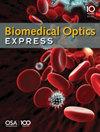基于深度学习的清除人类胶质瘤组织三维共聚焦显微镜图像血管提取技术
IF 2.9
2区 医学
Q2 BIOCHEMICAL RESEARCH METHODS
引用次数: 0
摘要
全面观察和准确提取肿瘤血管对研究胶质瘤的本质至关重要。目前,组织清除技术可以实现微米级分辨率的人类胶质瘤血管三维可视化,但现有的血管提取方案无法很好地应对现实条件下高度破坏和不规则的复杂肿瘤血管的提取。在此,我们开发了一个基于深度学习的框架 FineVess,用于自动提取共聚焦显微镜图像中已清除的人类肿瘤组织中的胶质瘤血管。在该框架中,我们设计了一个定制的深度学习网络(名为 3D ResCBAM nnU-Net)来分割血管,并开发了一个基于预处理和后处理的新管道来自动完善分割结果。通过对实际数据集的应用,我们发现 FineVess 能够在具有挑战性的三维图像中高精度地提取可变和不完整的血管,其效果优于其他传统和最先进的方案。对于提取的血管,我们计算了不同肿瘤等级的血管形态特征,包括分形维度和血管壁完整性,并通过定量分析验证了血管的异质性。本文章由计算机程序翻译,如有差异,请以英文原文为准。
Deep learning-based vessel extraction in 3D confocal microscope images of cleared human glioma tissues
Comprehensive visualization and accurate extraction of tumor vasculature are essential to study the nature of glioma. Nowadays, tissue clearing technology enables 3D visualization of human glioma vasculature at micron resolution, but current vessel extraction schemes cannot well cope with the extraction of complex tumor vessels with high disruption and irregularity under realistic conditions. Here, we developed a framework, FineVess, based on deep learning to automatically extract glioma vessels in confocal microscope images of cleared human tumor tissues. In the framework, a customized deep learning network, named 3D ResCBAM nnU-Net, was designed to segment the vessels, and a novel pipeline based on preprocessing and post-processing was developed to refine the segmentation results automatically. On the basis of its application to a practical dataset, we showed that the FineVess enabled extraction of variable and incomplete vessels with high accuracy in challenging 3D images, better than other traditional and state-of-the-art schemes. For the extracted vessels, we calculated vascular morphological features including fractal dimension and vascular wall integrity of different tumor grades, and verified the vascular heterogeneity through quantitative analysis.
求助全文
通过发布文献求助,成功后即可免费获取论文全文。
去求助
来源期刊

Biomedical optics express
BIOCHEMICAL RESEARCH METHODS-OPTICS
CiteScore
6.80
自引率
11.80%
发文量
633
审稿时长
1 months
期刊介绍:
The journal''s scope encompasses fundamental research, technology development, biomedical studies and clinical applications. BOEx focuses on the leading edge topics in the field, including:
Tissue optics and spectroscopy
Novel microscopies
Optical coherence tomography
Diffuse and fluorescence tomography
Photoacoustic and multimodal imaging
Molecular imaging and therapies
Nanophotonic biosensing
Optical biophysics/photobiology
Microfluidic optical devices
Vision research.
 求助内容:
求助内容: 应助结果提醒方式:
应助结果提醒方式:


